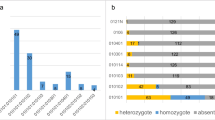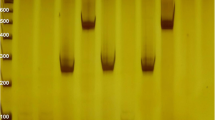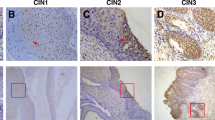Abstract
Epidemiological studies have demonstrated an association between HLA-DQB1*03 alleles and the risk of cervical cancer induced by human papillomavirus (HPV). As persistence of HPV infection is required for developing cervical cancer, we wanted to elucidate the role of HLA-class II allele polymorphisms in the persistence of common warts induced by HPV 2, HPV 27 or HPV 57. Therefore, we determined the distribution of HLA-DQA1, -DQB1, and -DRB1 alleles in 71 patients presenting with HPV 2/27/57-induced common warts which had persisted for at least 18 months as well as in 92 individuals who had never suffered from common warts or whose warts had healed in less than 18 months. Among patients with long-lasting warts, the carriership frequencies and allele frequencies of DQA1*0301, DQB1*0301, DRB1*07 and DRB1*09 were higher, and the allele frequencies of DQA1*0501, DQB1*0603, DRB1*01 and DRB1*03 were lower. Statistically significant differences (Bonferroni adjusted Fisher’s exact test) were found for carriership frequency of DQA1*0301 (46.5 vs 21.7%, P=0.013) and for carriership frequency (18.3 vs 1.1%, P=0.0015) and allele frequency (12 vs 0.5%, P=0.000013) of DQB1*0301. A greater proportion of patients with long-lasting warts than of subjects without persistent warts were homozygous at the DQA1 (14.1 vs 6.5%) and DQB1 (16.9 vs 8.6%) gene loci. These results suggest that the natural history of cutaneous HPV 2/27/57-induced common warts may be modulated by allele polymorphisms at the HLA-DQA1 and HLA-DQB1 gene loci.
Similar content being viewed by others
References
Aaltonen L, Partanen J, Auvinen E, Rihkanen H, Vaheri A (1999) HLA-DQ alleles and human papillomavirus DNA in adult-onset laryngeal papillomatosis. J Infect Dis 179:682–685
Apple RJ, Erlich HA, Klitz W, Manos MM, Becker TM, Wheeler CM (1994) HLA DR-DQ associations with cervical carcinoma show papillomavirus-type specificity. Nat Genet 6:157–162
Barzegar C, Paul C, Saiag P, Cassenot P, Bachelez H, Autran B, Gorochov G, Petit A, Dubertret L (1998) Epidermodysplasia verruciformis-like eruption complicating human immunodeficiency virus infection. Br J Dermatol 139:122–127
Baur MP, Neugebauer M, Albert ED (1984) Reference tables of two-locus haplotype frequencies for all MHC marker loci. In: Albert ED et al (eds) Histocompatibility Testing. Springer, Berlin Heidelberg New York, pp 677–681
Begovich AB, Klitz W, Steiner LL, et al (2000) HLA-DQ haplotypes in 15 different populations. In: Kasahara M (ed) The major histocompatibility complex: evolution, structure and function. Springer, Berlin Heidelberg New York, pp 412–426
Beskow AH, Josefsson AM, Gyllensten UB (2001) HLA class II alleles associated with infection by HPV16 in cervical cancer in situ. Int J Cancer 93:817–822
Bunney MH, Benton C, Cubie HA (1992) Viral warts. Biology and treatment, 2nd edn. Oxford University Press, Oxford, pp 51–52
Carrabba MG, Castelli C, Maeurer MJ, Squarcina P, Cova A, Pilla L, Renkvist N, Parmiani G, Rivoltini L (2003) Suboptimal activation of CD8(+) T cells by melanoma-derived altered peptide ligands: role of Melan-A/MART-1 optimized analogues. Cancer Res 63:1560–1567
Carrington M, Nelson GW, Martin MP, Kissner T, Vlahov D, Goedert JJ, Kaslow R, Buchbinder S, Hoots K, O’Brien SJ (1999) HLA and HIV-1: heterozygote advantage and B*35-Cw*04 disadvantage. Science 283:1748–1752
Cuzick J, Terry G, Ho L, Monaghan J, Lopes A, Clarkson P, Duncan I (2000) Association between high-risk HPV types, HLA DRB1* and DQB1* alleles and cervical cancer in British women. Br J Cancer 82:1348–1352
Doherty PC, Zinkernagel RM (1975) A biological role for the major histocompatibility antigens. Lancet 28:1406–1409
Engelhard VH (1994) Structure of peptides associated with class I and class II MHC molecules. Annu Rev Immunol 12:181–207
Ferencik S, Grosse-Wilde H (1997) Caucasian German normal. In: Terasaki PI, Gjertson DW (eds) HLA 1997. UCLA Tissue Typing Laboratory, Los Angeles, pp 222–223
Flores-Villanueva PO, Yunis EJ, Delgado JC, Vittinghoff E, Buchbinder S, Leung JY, Uglialoro AM, Clavijo OP, Rosenberg ES, Kalams SA, Braun JD, Boswell SL, Walker BD, Goldfeld AE (2001) Control of HIV-1 viremia and protection from AIDS are associated with HLA-Bw4 homozygosity. Proc Natl Acad Sci U S A 98:5140–5145
Gerlach JA (2002) Human lymphocyte antigen molecular typing: how to identify the 1250+ alleles out there. Arch Pathol Lab Med 126:281–284
Ghaderi M, Nikitina L, Peacock CS, Hjelmstrom P, Hallmans G, Wiklund F, Lenner P, Blackwell JM, Dillner J, Sanjeevi CB (2000) Tumor necrosis factor a-11 and DR15-DQ6 (B*0602) haplotype increase the risk for cervical intraepithelial neoplasia in human papillomavirus 16 seropositive women in Northern Sweden. Cancer Epidemiol Biomarkers Prev 9:1067–1070
Glew SS, Duggan-Keen M, Ghosh AK, Ivinson A, Sinnott P, Davidson J, Dyer PA, Stern PL (1993) Lack of association of HLA polymorphisms with human papillomavirus-related cervical cancer. Hum Immunol 37:157–164
Gostout BS, Poland GA, Calhoun ES, Sohni YR, Giuntoli RL II, McGovern RM, Sloan JA, Cha SS, Persing DH (2003) TAP1, TAP2, and HLA-DR2 alleles are predictors of cervical cancer risk. Gynecol Oncol 88:326–332
Grussendorf-Conen E-I, Jacobs S, Rübben A, Dethlefsen U (2002) Topical 5% Imiquimod long-term treatment of cutaneous warts resistant to standard therapy modalities. Dermatology 205:139–145
Han R, Breitburd F, Marche PN, Orth G (1992) Linkage and regression and malignant conversion of rabbit viral papillomas to MHC class II genes. Nature 356:66–68
Hildesheim A, Schiffman M, Scott DR, Marti D, Kissner T, Sherman ME, Glass AG, Manos MM, Lorincz AT, Kurman RJ, Buckland J, Rush BB, Carrington M (1998) Human leukocyte antigen class I/II alleles and development of human papillomavirus-related cervical neoplasia: results from a case-control study conducted in the United States. Cancer Epidemiol Biomarkers Prev 7:1035–1041
Hill AV (2001) The genomics and genetics of human infectious disease susceptibility. Annu Rev Genomics Hum Genet 2:373–400
Höhn H, Pilch H, Gunzel S, Neukirch C, Freitag K, Necker A, Maeurer MJ (2000) Human papillomavirus type 33 E7 peptides presented by HLA-DR*0402 to tumor-infiltrating T cells in cervical cancer. J Virol 74:6632–6636
Llewelyn M, Sriskandan S, Peakman M, Ambrozak DR, Douek DC, Kwok WW, Cohen J, Altmann DM (2004) HLA class II polymorphisms determine responses to bacterial superantigens. J Immunol 172:1719–1726
Maciag PC, Schlecht NF, Souza PS, Rohan TE, Franco EL, Villa LL (2002) Polymorphisms of the human leukocyte antigen DRB1 and DQB1 genes and the natural history of human papillomavirus infection. J Infect Dis 186:164–172
Madeleine MM, Brumback B, Cushing-Haugen KL, Schwartz SM, Daling JR, Smith AG, Nelson JL, Porter P, Shera KA, McDougall JK, Galloway DA (2002) Human leukocyte antigen class II and cervical cancer risk: a population-based study. J Infect Dis 186:1565–1574
Odunsi K, Ganesan T (2001) Motif analysis of HLA class II molecules that determine the HPV associated risk of cervical carcinogenesis. Int J Mol Med 8:405–412
Odunsi K, Terry G, Ho L, Bell J, Cuzick J, Ganesan TS (1996) Susceptibility to human papillomavirus-associated cervical intra-epithelial neoplasia is determined by specific HLA DR-DQ alleles. Int J Cancer 67:595–602
Olerup O, Aldener A, Fogdell A (1993) HLA-DQB1 and -DQA1 typing by PCR amplification with sequence-specific primers (PCR-SSP) in 2 hours. Tissue Antigens 41:119–134
Olerup O, Zetterquist H (1992) DR “low-resolution” PCR-SSP typing—a correction and an up-date. Tissue Antigens 41:55–56
Olerup O, Zetterquist H (1992) HLA-DR typing by PCR amplification with sequence-specific primers (PCR-SSP) in 2 hours: an alternative to serological DR typing in clinical practice including donor-recipient matching in cadaveric transplantation. Tissue Antigens 39:225–235
Reed AM, Collins EJ, Shock LP, Klapper DG, Frelinger JA (1997) Diminished class II-associated Ii peptide binding to the juvenile dermatomyositis HLA-DQ alpha 1*0501/DQ beta 1*0301 molecule. J Immunol 159:6260–6265
Rübben A, Krones R, Schwetschenau B, Grußendorf-Conen E-I (1993) Common warts from immunocompetent patients show the same distribution of human papillomavirus types as common warts from immunocompromised patients. Br J Dermatol 128:264–270
Rübben A, Traidl C, Baron JM, Grussendorf-Conen E-I (1995) Evaluation of non-radioactive temperature gradient SSCP analysis and of temperature gradient gel electrophoresis for the detection of HPV 6-variants in condylomata acuminata and Buschke-Loewenstein tumours. Eur J Epidemiol 11:501–506
Rübben A, Kalka K, Spelten B, Grußendorf-Conen E-I (1997) Clinical features and age distribution in patients with HPV 2/27/57-induced common warts. Arch Dermatol Res 289:337–340
Sanjeevi CB, Hjelmstrom P, Hallmans G, Wiklund F, Lenner P, Angstrom T, Dillner J, Lernmark A (1996) Different HLA-DR-DQ haplotypes are associated with cervical intraepithelial neoplasia among human papillomavirus type-16 seropositive and seronegative Swedish women. Int J Cancer 68:409–414
Tang J, Costello C, Keet IP, Rivers C, Leblanc S, Karita E, Allen S, Kaslow RA (1999) HLA class I homozygosity accelerates disease progression in human immunodeficiency virus type I infection. AIDS Res Hum Retroviruses 15:317–324
The Central Data Analysis Committee (1991) Allele frequencies, section 6.3 splits combined (five loci). In: The Data Book of the 11th International Histocompatibility Workshop, vol 2. Yokohama, pp 807–814
Thursz MR, Thomas HC, Greenwood BM, Hill AV (1997) Heterozygote advantage for HLA class-II type in hepatitis B virus infection. Nat Genet 17:11–12
Wang SS, Wheeler CM, Hildesheim A, Schiffman M, Herrero R, Bratti MC, Sherman ME, Alfaro M, Hutchinson ML, Morales J, Lorincz A, Burk RD, Carrington M, Erlich HA, Apple RJ (2001) Human leukocyte antigen class I and II alleles and risk of cervical neoplasia: results from a population-based study in Costa Rica. J Infect Dis 184:1310–1314
Wank R, Meulen JT, Luande J, Eberhardt H-C, Pawlita M (1993) Cervical intraepithelial neoplasia, cervical carcinoma, and risk for patients with HLA-DQB1 *0602, *0301, *0303 alleles. Lancet 341:1215
Wank R, Thomssen C (1991) High risk of squamous cell carcinoma of the cervix for women with HLA-DQw3. Nature 352:723–725
Zinkernagel RM, Doherty PC (1974) Restriction of in vitro T cell-mediated cytotoxicity in lymphocytic choriomeningitis within a syngeneic or semiallogeneic system. Nature 248:701–702
Acknowledgements
This study was supported by grants DFG GR 641/4-1, and DFG RU 329/1-1.
Author information
Authors and Affiliations
Corresponding author
Rights and permissions
About this article
Cite this article
Spelten, B., Grußendorf-Conen, EI. & Rübben, A. Human leukocyte antigen class II alleles and natural history of HPV 2/27/57-induced common warts. Arch Dermatol Res 296, 105–111 (2004). https://doi.org/10.1007/s00403-004-0485-0
Received:
Revised:
Accepted:
Published:
Issue Date:
DOI: https://doi.org/10.1007/s00403-004-0485-0




